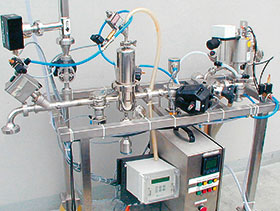

Sterile air filters are needed for dairy technology and for other sterile processes such as in the pharmaceutical industry. They serve, for example, to bleed piping systems after steam sterilisation, to ventilate containers and tanks when the filling levels vary or to decontaminate laminar flow of air in order to prevent those system components which are to be kept sterile from coming into contact with the contaminated atmosphere.
Sterile air filters serve as an interface between a sterile area and the surrounding atmosphere. Therefore, they must be viewed as an important part of a sterile system and their function significantly influences the quality of the product. The weaknesses of the sterile air filters are often insufficient monitoring, contaminated condensate and, above all, a working life that is too short. In close cooperation with the German Institute Versuchsanstalt des Fachzentrums fur Milchwirtschaft (Research Institute of the Competence Centre for Dairy Farming), Gemü has investigated this together with industry. After analysis of the technical status and an intensive development and testing phase, a sterile air node was developed to achieve optimum operating safety and filter working life according to today’s state of the art technology. In this case, the filter elements survive in excess of 230 sterilisation cycles in reproducible experiments.
Plant design constraints
In order to reduce the distance on the sterile air side, avoid deadlegs and to operate the steam line without puddles and without condensate banking, as many functions as possible are grouped in one central valve block. It is based on the diaphragm valve principle through which all mechanical valve parts are located outside the media-wetted area and only smooth internal geometries prevail. The sterile airline is steam pre-heated in order to avoid the formation of condensate. A defined gradient serves for dehydration purposes. Diaphragm valves are always installed before the condensate charge eliminators. In order to deal with unfavourable and changing pressure situations, regulated valves with motorised actuators are used and a stainless steel sintered element installed before the filter. Stainless steel globe valves control the steam.
The Gemü solution
The Gemü 600 central valve block is designed according to its task and worked from a single piece of stainless steel. The surfaces are ground and polished in accordance with its application. Gemü 650 valves with pneumatic stainless steel actuators, Gemü 653 manually operated valves with stainless steel bonnet and integrated seal adjuster and stroke limiter, and Gemü 698 motorised valves can be used for activation purposes. The sterile air is regulated by a special Gemü 568 stainless steel globe valve with a regulating cone and a safely diaphragm. Steam is controlled using Gemü 540 stainless steel pneumatic globe valves with various control functions. Electro-magnetically activated Gemü 3243/2-way valves, which are directly attached to the pneumatic actuators, serve as pilot valves.
For more information contact Claudio Darpin, Gemü Valves Africa, +27 (0)11 462 7795, [email protected], www.gemu-group.com

© Technews Publishing (Pty) Ltd | All Rights Reserved